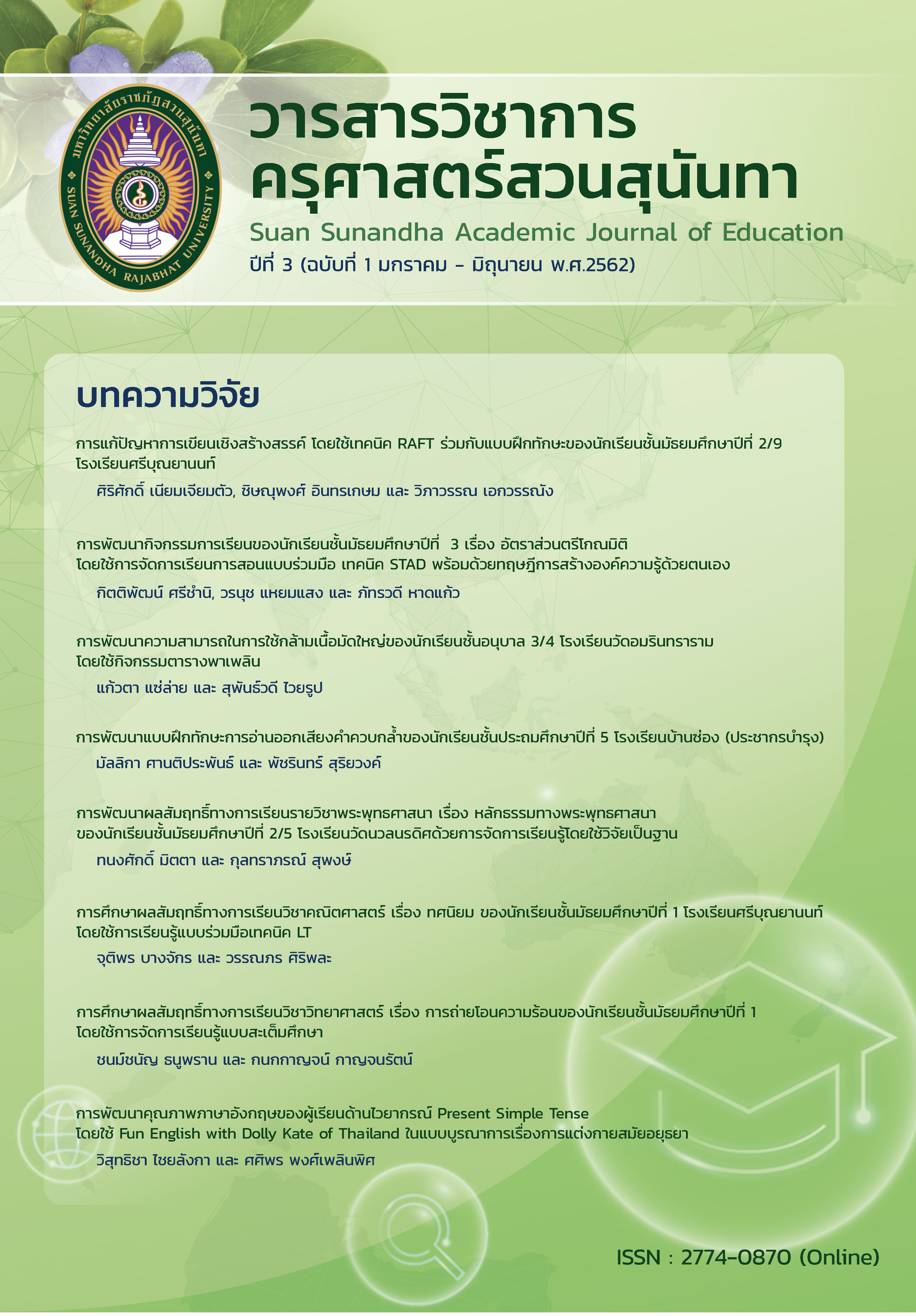The Development of Activities Based on the Stad-Collaborative Learning Strategy and Constructivism in Trigonometry for Mattayomsuksa 3 Students
Keywords:
STAD - collaborative learning strategy, constructivism, TrigonometryAbstract
This is a quasi - experimental research with one group pretest – posttest design. This study aims to : (1) Develop learning activities based on the STAD - Collaborative Learning Strategy and Constructivism in Trigonometry to reach 80/80 efficiency criteria, (2) Compare learning achievement in Trigonometry of Mattayomsuksa three students before and after participating in the learning activities based on the STAD - Collaborative Learning Strategy and Constructivism, and (3) Study satisfaction with the learning activities based on the STAD - Collaborative Learning Strategy and Constructivism in Trigonometry of Mattayomsuksa three students. Sample of this study was 40 students who were studying in Mattayomsuksa three at Mattayom Watnongchok School, Bangkok, in the second semester of 2018 academic year. The research sample was selected by cluster random sampling to get one out of twelve classrooms. The data collected in this study was analyzed for arithmetic means in order to explain the efficiency of learning activities and satisfaction of students with the learning activities. The data was also analyzed dependent – sample t test in order to compare students’ achievement before and after participating in the learning activities. Results of the study reveal that : 1. Designed learning activities based on the STAD - Collaborative Learning Strategy and Constructivism in Trigonometry show efficiency at 91.52/93.56 which reaches 80/80 efficiency criteria. 2. Learning achievement in Trigonometry of Mattayomsuksa three students after participating in the learning activities based on the STAD - Collaborative Learning Strategy and Constructivism in Trigonometry is significantly higher than those before participating in the activities at 99% confidence interval. 3. Satisfaction with learning activities based on the STAD - Collaborative Learning Strategy and Constructivism in Trigonometry of Mattayomsuksa three students is at very high level with an arithmetic mean at 4.8217.
References
กระทรวงศึกษาธิการ. (2551). หลักสูตรแกนกลางการศึกษาขั้นพื้นฐาน พุทธศักราช 2551 (พิมพ์ครั้งที่ 3). กรุงเทพฯ: โรงพิมพ์ชุมนุม สหกรณ์การเกษตรแห่งประเทศไทย.จำกัด.
กุลวดี สร้อยวารี. (2553). ผลสัมฤทธิ์ทางการเรียนคณิตศาสตร์เรื่อง จำนวนเชิงซ้อนโดยวิธีการจัดการเรียนรู้แบบร่วมมือ แบบแบ่งกลุ่มผลสัมฤทธิ์ (STAD) (วิทยานิพนธ์ปริญญามหาบัณฑิต). กรุงเทพฯ: มหาวิทยาลัยรามคำแหง.
เพ็ญประภา อุดมฤทธิ์. (2558). ผลสัมฤทธิ์ทางการเรียนคณิตศาสตร์ โดยใช้ ชุดการเรียนการสอน เรื่อง สมการกำลังสองของนักเรียนชั้นมัธยมศึกษาปีที่ 3 ตามแนวคิดคอนสตรัคติวิสต์ร่วมกับวิธีการเรียนแบบร่วมมือเทคนิค STAD. (วิทยานิพนธ์ปริญญามหาบัณฑิต). กรุงเทพฯ: มหาวิทยาลัยรามคำแหง.
วัลยา บุญอากาศ. (2556). ผลการจัดการเรียนรู้แบบร่วมมือเทคนิค STAD ที่มีต่อผลสัมฤทธิ์ทางการเรียนและทักษะการคิดวิเคราะห์วิชาคณิตศาสตร์ของนักเรียนชั้นประถมศึกษาปีที่ 6. (วิทยานิพนธ์ปริญญามหาบัณฑิต).จันทบุรี : มหาวิทยาลัยราชภัฏรําไพพรรณี.
อทิติยา สวยรูป. (2556). การศึกษาผลสัมฤทธิ์ทางการเรียนในรายวิชา เทคโนโลยีสารสนเทศ เรื่อง คอมพิวเตอร์เบื้องต้นของนักเรียนชั้นมัธยมศึกษาปีที่ 1 ด้วยการเรียนการสอนแบบกลุ่มร่วมมือโดยใช้เทคนิค STAD. (วิทยานิพนธ์ปริญญามหาบัณฑิต). มหาวิทยาลัยหาดใหญ่.
Slavin, Robert E. ; (1980). Cooperative Learning. Washington. D.C.: National Education Association.




